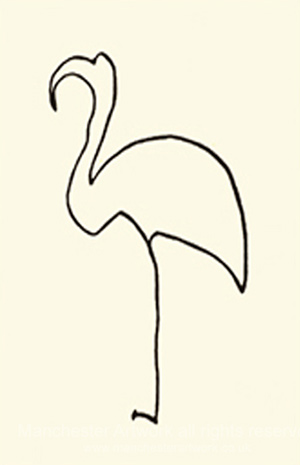Art lovers are used to marvelling at the masterpieces of this great Spanish painter, and at the prolific output of his long and eventful career. However, to fully grasp his genius, it's essential to start with one of the many basic line sketches, such as the Flamingo drawing by Pablo Picasso.
Picasso was also a sculptor, ceramicist, stage designer and printmaker, moving through a variety of phases.
Their simplicity of form strips away all distraction, leaving his natural ability at its most visible. An unbroken line was quickly executed with a light touch that actually served to increase its power.
The fact that the discipline also proved ideal for experimentation, at any time and anywhere, allowed Picasso to play with these ideas throughout his life, producing sketches of animals, portraits, myths and objects. His many pets gave him plenty of opportunity to observe the way animals move and hold themselves, with his dog Lump being a favourite with artist and admirers alike.
One continuous line of chalk or pencil could convey shape, form and characteristics, and this is especially true of the Flamingo drawing, which lends itself naturally to a single-line drawing. Picasso could have seen flocks of these striking pink birds in a Paris Zoo or perhaps in the Camargue region of southern France. They often stand on one leg, and here the subject balances effortlessly.
More detailed outlines often became etchings, many of which are now housed in New York's Museum of Modern Art. However, the sheer numbers created by the artist mean that these bold depictions are represented in institutions worldwide, making them accessible to the widest audience possible. The unbroken lines are deceptively simple, because of course, to portray something accurately with one quick flourish is actually very difficult.
Other artists known for their line drawings include Gustav Klimt, Egon Schiele, Rembrandt, Michelangelo, and Picasso's own friend and rival Henri Matisse, while Pablo himself was also influenced by the dancers of Edgar Degas. Among his accomplished portraits with pencil on grey paper were those of the composers Erik Satie and Stravinsky, the latter done while the two were collaborating on Pulcinella in 1920.
It's said that the infant Pablo could draw before he could speak, thanks to his artistic father. The son went on to change the face of modern art, co-founding the Cubist movement with Georges Braque, passing through both Blue and Rose periods, and exploring primitivism and surrealism. His art was revolutionary and yet he retained the ability to strike a chord with the most unsophisticated viewer.
Born in Málaga in 1881 and raised first in Galicia and then Barcelona, during what were undoubtedly his formative years, he remained rooted in the Catalan capital. However, in the early nineteen-hundreds this most Spanish of painters moved to France, where he died in Mougins, part of the Alpes-Maritimes of south-eastern France. He had refused to return to Franco's Spain after 1934, with his death in 1973 preceding that of the dictator by two years.


